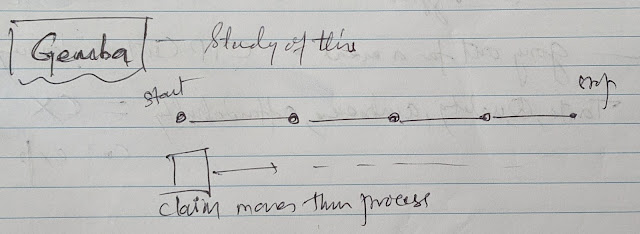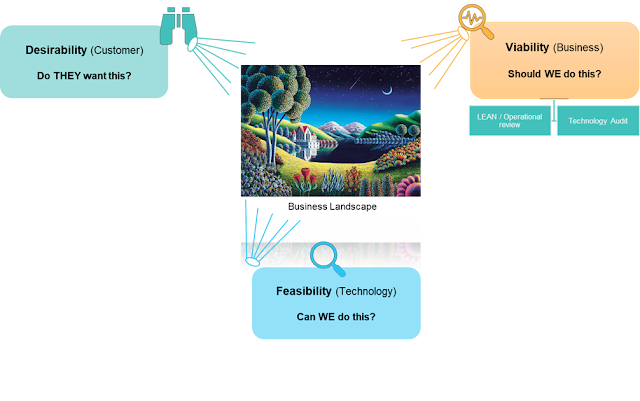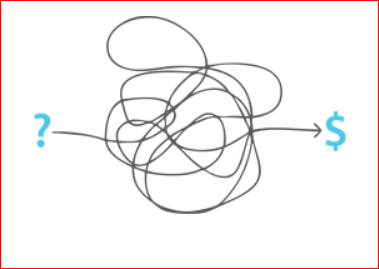Scraps from various sources and my own writings on Generative AI, AGI, Digital, Disruption, Agile, Scrum, Kanban, Scaled Agile, XP, TDD, FDD, DevOps, Design Thinking, etc.
Page Hits
Tuesday, June 16, 2020
Monday, June 15, 2020
Lean Brownbag
- Lean is a philosophy or methodology
- Isn't something you do
- You "think" in a lean way.
- You use tools to embody
Lean Definition
Lean is a (1) systemic (2) pursuit of perfection with (3) relentless identification and (4) elimination of waste and (5) non-value added work.
There are five aspects of it as seen in the above statement.
- Systemic
- Pursuit of perfection
- Relentless Identification
- Elimination of waste
- Non-value-added work
- Sakichi Toyoda -- Toyota Motor Corporation
Flow
Achieve smooth flow as in a river
Rocks, leaves/ branches inhibit the flow
When the flow is smooth --- waste is minimal, and velocity is high VICE VERSA.
Three kinds of work
- Value-added (VA). All three must be met for a task to be value-added.
- This is something the customer is willing to pay $
- It is right the first time. Rework is a waste
- Transformational meaning changes form (physical characteristics of the product like shape, weight, colour, etc.) / fit (fits intended application) / function (Function of what the product actually does) -- the task must change the form fit or function of the product for it to be considered value-added. An exception though is an inspection at the assembly line - it is required so we don't let out a bad product.
- Value enabling work (VE)
- Is something that has potential for elimination in future but not immediately.
- Some but not all of change to form / fit or function.
- Example banks doing a credit check - would you be willing to pay for it. I won't be. But it also depends on who the customer is. An individual wouldn't pay, however if the customer is a bank, it would be willing to pay.
- VE is usually related to regulatory / compliance (SIRA for long tail claims).
- Non-value added work (NVA)
- This is waste
- Waiting - no changes to form, fit or function.
- Rework - not done fight first time
- Transportation - Movement of work between work stations.
- Movement - How do you work? work moves between me, manager, to someone else, back to me, goes in loops. All this is waste.
- Overproduction - too much of production
- Over-processing - do something even before it is needed.
- Inventory - excessive inventory, order only what you need
- Not utilizing staff to full potential - using a highly skilled person to do silly jobs.
Gemba
Value stream
Friday, June 12, 2020
Ideation Workshop
IDEATION WORKSHOP
=================
=================
1. Background
2. Research snapshot
3. Key insights / opportunity statement / HMWs
4. Overview of key insights
5. Data story / overview
6. Key Insights in detail
- Insight statement
- Snapshot of the problem
- Insights into our processes & capability around the problem area
- What we have heard from customers (Medallia)
7. Reflections -- discuss on what has been presented
8. IDEA GENERATION
==================
-- Re-focus on your problem
- familiarise with problem you are solving
-- Generate as many ideas as you can - 8 ideas, 5 mins, quantity not quality, write or draw
- 8 ideas
- 5 minutes
- Quantity not quality
- Write or draw
--- Share ideas on your table - 1 min each, no feedback, listen and get inspired
- 1 min each
- No feedback
- Listen and get inspired
--- Document 2 best ideas
- 10 mins each
- 2 ideas
- Picture description, title
- Take inspiration from others
--- Share 2 best ideas and get feedback
- 1 min pitch
- 2 mins feedback
- Write down your feedback
- Listen don't defend
--- Incorporate feedback
- 10 mins
- Evolve your idea based on feedback
--- Prioritise ideas
- Group similar ideas, but keep them distinct! Don’t make them too big.
- Agree on groups
- Name each group
- Vote! One dot per person
- Which idea best addresses the problem we are solving for?
- Select top 3
--- Share 3 ideas and get feedback
- 10 mins share
- 10 mins feedback
- Write down feedback
- Listen don't defend
--- Choose best idea
- Review feedback
- Select top idea
- Which idea solves the prob you are trying to solve?
9. STORYBOARDING
================
--- Flesh out ideas
- 20 mins
- Write down the ‘steps’ in the experience
- Circle 6 key steps
- Draw each scene
of the experience
- Capture customer perspective:
think, feel, do
--- How do we bring this to life?
- 15 mins
- What do we need from customers, business, process/tech/data, our people?
--- What would stop us?
- 10 mins
- What are the key barriers and how do we overcome them?
10. DEFINE MVP
=============
--- Define your MVP
- What's the elevator pitch
- How does it work?
- What is the customer and business value?
- Must haves vs. nice to have's
- What does success look like?
- How will we support our people to deliver?
--- Pitch MVP to room
11. NEXT STEPS
==============
--- Review and iterate on ideas (the above ideas)
--- Prioritise and select top idea
--- Assess viability and feasibility
--- Test with customers (prototype and test with customers)
Wednesday, June 10, 2020
Subscribe to:
Comments (Atom)
If we already have automation, what's the need for Agents?
“Automation” and “agent” sound similar — but they solve very different classes of problems. Automation = Fixed Instruction → Fixed Outcome ...
-
Requirements Analysis -- Business requirements document or business requirements specification System Design -- Systems requireme...






